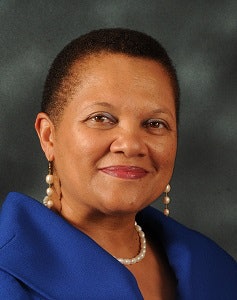Growth and graduation are two main themes that characterized Dr. Cheryl Davenport Dozier’s eight-year tenure as president of Savannah State University.
 Dr. Cheryl Davenport Dozier
Dr. Cheryl Davenport DozierFrom academics and co-curriculars to finances and capital improvements, every enhancement at the historically Black university (HBCU) ultimately was about helping more students attend and complete college.
“Students are first in everything I have accomplished in my years in higher education,” says Dozier, whose final day is June 30. “Helping students enter and leave with a degree has really been the highlight of my career at Savannah State.”
The vision of “matriculation to graduation” had buy-in from every constituency in the campus community, says Dozier, which fueled its success in achieving record enrollment and increasing graduation rates.
Before arriving at SSU, Dozier worked for 17 years at the University of Georgia, where her roles included associate provost and chief diversity officer, social work professor and assistant vice president for academic affairs at the Gwinnett University Center. The noted researcher and professor also directed the Ghana Interdisciplinary Study Abroad Program for more than a decade as an African Studies faculty member.
When Dozier arrived at SSU in 2011, the university’s endowment was below $4 million, which wasn’t unusual for an HBCU. She led the institution into its first major capital initiative, the “Transformation and Growth” campaign, which was launched during the school’s 125th anniversary and has raised upwards of $8 million.
Appreciating the importance of finances to student success, she established a Closing the Gap Fund her first year that has helped more than 150 students pay for their final semester. Later, she created a board of visitors that awards four-year scholarships primarily to students from the vicinity.
Dozier devoted as much effort to expanding academic offerings and research, broadening the school’s global engagement and seeing through renovations and new construction initiated prior to and during her tenure.
And facing her were two of her biggest challenges: athletics and safety.
In 2017, she made a difficult decision to remove SSU from MEAC in Division 1 and return to the SIAC conference of Division 2. It was fundamentally a financial stewardship issue that will come to fruition as she leaves the school, she says.
As tough as that decision was, the challenge that she says “kept me awake at night” was concern about student safety, whether the threat might come as a horrific assault or a deadly shooting incident.
Although the university put preventive safety measures in place, being president is “a job where you can’t turn off your phone and you have to be ready and vigilant to address those challenges,” she says.
Beyond the campus, Dozier has served in many local, regional and national capacities, from the governing board of Telfair Museums to the Savannah Area Chamber of Commerce CEO Council to an appointment by the governor to the Georgia Child Welfare Reform Council.
During her term on the American Council on Education’s Commission on Internationalization and Global Engagement, she stood out for two main reasons, says Brad
Farnsworth, vice president for internationalization and global engagement there.
“One was she was representing an HBCU and really gave us a clear sense of the needs of underrepresented students and how to get them involved in international programming and especially study abroad,” says Farnsworth.
“The other thing is – this is unusual for the president of any institution – she has experience in managing international programs. So she could speak with great knowledge and experience about what it takes to motivate students to study abroad. Cheryl was just the ideal person to help us address that as an organization.”
Dr. Mildred García, president of the American Association of State Colleges and Universities, says she is grateful for Dozier’s involvement in AASCU and wishes her well in retirement.
“As an active member of the association, she has chaired the advisory committee of the Millennium Leadership Institute, a program now in its 21st year, whose goal is to diversify the university presidency,” says Garcia, “and she has served as a mentor to many participants of the institute who desire to become a college or university president.”
In retirement, Dozier plans to spend more time with family and rejuvenate. Then she will take a page out of former first lady Michelle Obama’s book, Becoming, and reinvent herself.
That will include returning to the professoriate, consulting, working with schools to help students navigate the college application process and maintaining involvement with her church, Alpha Kappa Alpha sorority, AASCU and MLI.
“I look forward to being a voice in the community at large,” she says.
International travel also is on the agenda, she says. She travels to Africa about once a year and, in July, will head to Ghana with family and friends – and, for the first time, without students and faculty.
She’s also creating an endowment at Savannah State to help students of the future.
Dr. Beauty Baldwin, an avid alumna of SSU, says she met Dozier shortly after Dozier arrived on campus and immediately was impressed with the new leader’s interest in students. A group of students walked by while they were conversing, Baldwin recalls, and Dozier excused herself to greet them.
“She’s probably one of the best leaders we’ve ever had as president,” says Baldwin, who graduated in 1963 with a degree in mathematics. “The students came first.”
This is one in a series of articles about retiring college presidents that appeared in the June 27, 2019 issue of Diverse.





















